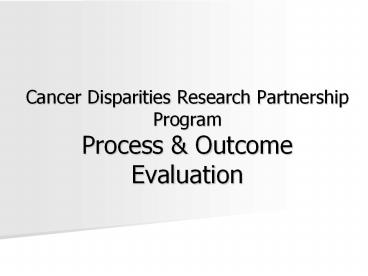Cancer Disparities Research Partnership Program Process - PowerPoint PPT Presentation
Title:
Cancer Disparities Research Partnership Program Process
Description:
Cancer Disparities Research Partnership Program Process & Outcome Evaluation Purpose of Evaluation Measure relevance, effectiveness, and impact of CDRP Program in a ... – PowerPoint PPT presentation
Number of Views:225
Avg rating:3.0/5.0
Title: Cancer Disparities Research Partnership Program Process
1
Cancer Disparities Research Partnership
ProgramProcess Outcome Evaluation
2
Purpose of Evaluation
- Measure relevance, effectiveness, and impact of
CDRP Program in a consistent fashion - Evaluation findings to identify Program
attributes to be applied to other settings - Meaningful annual reports for stakeholders within
and outside the NCI
3
Type of Program Evaluation
- 3-year evaluation
- Process components
- Is program being implemented as planned
- Is targeted audience being reached
- Outcome components
- Were short-term and intermediate objectives
achieved
4
Evaluation Design Focus of Key Questions
- Improvement and conduct of radiation oncology
clinical research in community-based health care
institutions serving large populations
experiencing health disparities - Clinical trial participation by target
populations - Influence of partnerships between awardee
institutions and academic research centers - Influence of TELESYNERGY
- Influence of Patient Navigation
5
CDRP Program Conceptual Framework
6
Target Populationsfor Evaluation Data Collection
- Cancer patients from targeted populations
experiencing cancer health disparities - Principal Investigators, participating radiation
oncologists, and awardee institution staff - Patient Navigators
7
Data Sources
- Archival Data
- CDRP Database
- Program-related written documents
- PI meeting minutes, organizational records and
charts - Historical data on local cancer incidence,
prevalence, mortality - Baseline data on clinical trials and research
activities at participating sites
- New Data
- In-depth structured interviews with PIs and
partners - Patient focus groups
- Group interviews with Patient Navigators and
Navigator support staff - Surveys on issues related to recruitment to
clinical trials
8
Comparison Group
- 6 similar community-based radiation oncology
facilities - Comparison sites will be chosen based on same
criteria as stated in RFA - Conduct brief survey about independent and
collaborative clinical research capabilities and
current participation in radiation oncology
clinical trials
9
Data Analysis
- Each program component will be analyzed
- Clinical trials
- Partnerships between awardee and academic partner
- TELESYNERGY
- Patient Navigation
- Sources of information will be combined to
analyze overall Program and linkages
between/among components.
10
Data Analysis (continued)
- Quantitative
- Descriptive statistics
- Complex analyses and causal modeling
- Resource cost-allocation analysis
- QualitativeThematic Analysis
- Intended and unintended successes
- Failures
- Critical incidents
- Lessons learned
- Recommendations for future programs
11
Evaluation Advisory Committee
- Norman Coleman, M.D. NCI/DCTD/RRP
- Larry Solomon, Ph.D.NCI/OSPA
- Paul Johnson, Ph.D.NICHD/OSPAC
- Ted Trimble, M.D.NCI/DCTD/CTEP
- Martin Ojong-Ntui, M.D.Chief, Radiation
Oncology, GWU Cancer Center - Frank Govern, Ph.D. NCI/DCTD/RRP
12
Evaluation Advisory CommitteeRoles and
Responsibilities
- Provide advice on programmatic needs and types of
information RRP needs - Provide guidance to ensure validity of evaluation
design, approach, and data analysis - Data Quality Subcommittee
- Review data collection methods and data analyses
for accuracy, biases, interpretations, and
conclusions - Make recommendations for maintenance and/or
improvement of data management and data quality
assurance
13
Products of Evaluation Reports
- Annual process/progress reports
- Program implementation, accomplishments, and
progress to date - Needed midcourse changes to meet objectives.
- Final outcome report
- Evidence about Programs attainment of goals and
expected outcomes. - Summarize plausible mechanisms of change
- Delineate temporal sequences between activities
and effects
14
Evaluation Timeline































